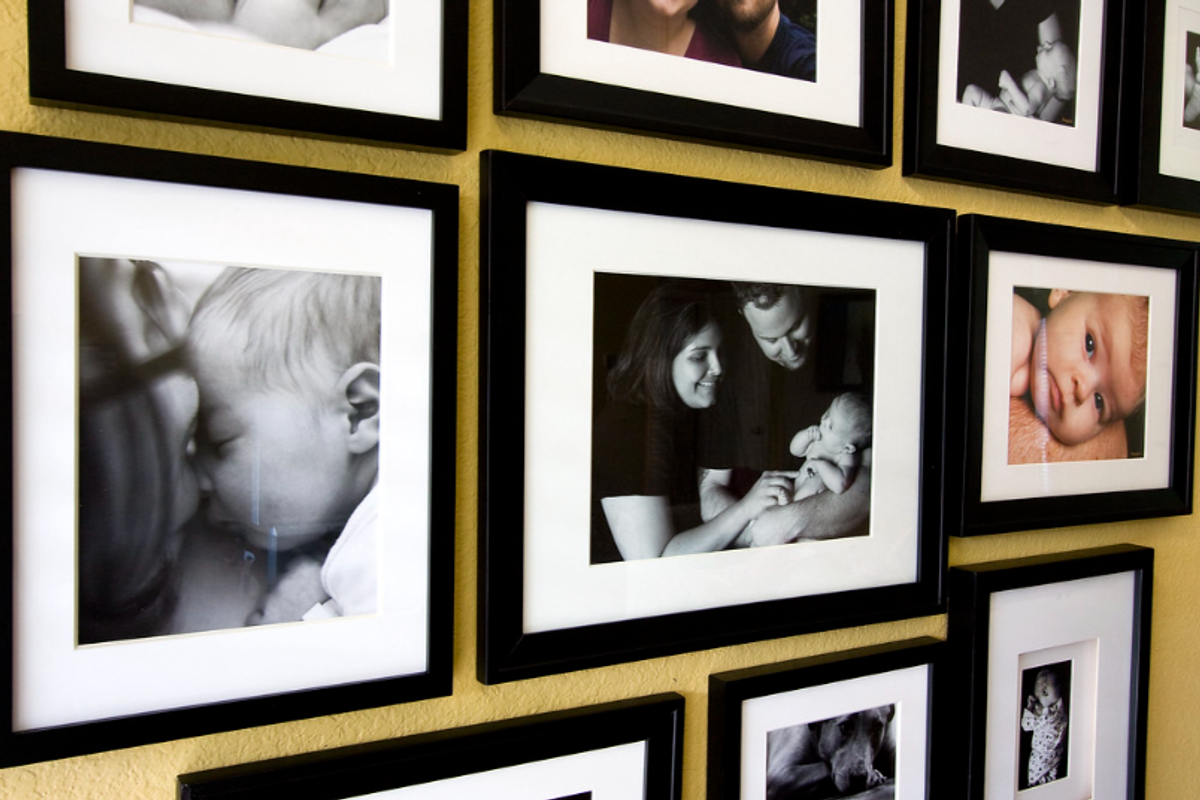Interior designer says that having family photo 'shrines' in the house is poor taste
Is decorating with family photos tacky?
A collage of family photos.
Shannyn Weiler, a Utah-based interior designer, has caused a debate on TikTok after she urged people to use caution when displaying family photos in the home. The discussion started a debate over whether a home should be decorated for visitors or the family itself and if having a “shrine” dedicated to family members is tasteful.
The video began with a stitch from a designer passionately saying that one should “never’ display “personal photos” in the living room.
“So family photos can become a problem when they become what I refer to as the shrine,” Weiler begins the video. She shared an example from her life, to make the case why family photos should be hung judiciously.
“I got married when I was 21,” she shares. “We were both in school, absolutely broke, we had $50 to buy a couch, so imagine what type of couch that was. We went to go decorate our first apartment and lo and behold, there’s no money for decoration. So we do what most newlyweds do, we use our wedding photos, because we’re so cute and we’re so in love and we just love our wedding day. Everywhere in our apartment was wedding photos… it felt like what I call ‘the shrine.’”
“It’s very real. This also happens if you have one baby, and you might have baby photos taken and it’s the shrine to the one kid,” she continues. “This also happens if you have one grandkid.”
@shannynweiler Interior design art tips Art decor interior design Interior design 2024 art prints Interior design art trends 2024 interior design trends #hometips #homedecor #wallart #decortips #walldecor #interiordesign
Weiler believes that people should hang artwork or photography about more than one subject.
“They can’t just be on every wall with one subject,” she says. “We need to mix it up. There needs to be a mirror in the space. We need some Etsy art prints or something like that. We just need to mix it together to get rid of that shrine feel.”
The post bothered many who love having pictures of their family around the house. The vast majority of commenters were people who love having family photos strewn about their homes
"The house is for us not company," Sarah Murdock, the most popular commenter, wrote. "I’d rather have pics of my kids and our life up than prints of random flowers and art," Ty Harman added.
"I grew up in an interior design magazine and HATED that my mom never displayed any photos of my family. Felt like she cared more about material things," Alexandra DiGiovanni wrote.
Others noted that people decorate their homes for themselves, not for guests.
"OR we do what we want with the homes WE live in, not guests," Ergot wrote. "I like myself, I don't have a problem seeing myself everywhere. After all, I paid the bills," Gege Chic added.
Some people agreed with the interior decorator and said that having too many family photos in a house looks tacky.
"YES. Photographs of ourselves in my own house feel so weird to me. Narcissistic kind of Jamiecakes wrote. "I don't have a single photo of a person in my house. I think they look tacky," C wrote. "One friend's house comes to mind for me, it was tacky (for me) to see nothing but wedding pics. Like, do you have other interests? Just my opinion but also, they’re divorced now. Mixing in art helps," _sigred added.
Even though the post received a pretty sizable backlash, Weiler’s opinion is widely accepted in design circles. “To us, having too many portraits of yourself on display in your home is kind of like having a tattoo of yourself on your own body. It can come off as vain and tacky,” Sarah Han writes at Apartment Therapy.
After her thoughts on family photos went viral, Weiler posted a follow-up video where she shared an example of a student changing their mind about home decor.
“Sometimes in design, we hear the design ideas and go, 'Mmm nope, that's not for me.' Sometimes, we try those ideas and we still say, 'Nope, that's not for me.' But occasionally we try things and we go, 'Okay, I do kind of like that,’” Weiler concluded her video.
@shannynweiler reply to @Shannyn #homedecor #interiordesign #hometips #interiordesigntrends2024 #wall art
This article originally appeared last year.
- People are sharing the marriage advice that 'sounded absurd' but is actually really helpful ›
- 7 practical tips for creating more hygge in your home ›
- The 15 small upgrades that made a ‘huge difference’ in people's homes ›
- Woman's simple, drill-free garland hanging trick hailed the ultimate Christmas decor hack ›
- Do you have a 'living room family' or a 'bedroom family'? - Upworthy ›
- A woman joked that she need a 'cry room.' So her husband built one for her. - Upworthy ›
- Interior designer says having family photo 'shrines' in your house is tacky - Upworthy ›

